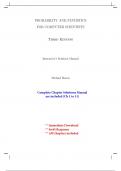PROBABILITY AND STATISTICS
FOR COMPUTER SCIENTISTS
Third Edition
Instructor’s Solution Manual
Michael Baron
Complete Chapter Solutions Manual
are included (Ch 1 to 11)
** Immediate Download
** Swift Response
** All Chapters included
, Table of Contents
Chapter 1 solutions 3
Chapter 2 solutions 4
Chapter 3 solutions 15
Chapter 4 solutions 29
Chapter 5 solutions 44
Chapter 6 solutions 50
Chapter 7 solutions 58
Chapter 8 solutions 71
Chapter 9 solutions 75
Chapter 10 solutions 88
Chapter 11 solutions 115
Appendix 1: R codes for exercises-projects 136
Appendix 2: Matlab codes for exercises-projects 139
, Chapter 1 3
Chapter 1
1.1 Examples: the time I woke up; weather; my morning coffee temperature; drive to the
university, the time it took and road conditions; street lights at all intersections; cars
that shared the road with me, their size, brand, speed, and driving culture; whether
they yield to me or not; availability of parking spaces; lectures, their exact duration,
the level of difficulty, how much I understood, how many questions my classmates
asked; computer lab, availability of computers, internet traffic; homework, its length,
level of difficulty, how much time it took me; the hockey game that I watched, its
score, who scored, penalties, level of excitement; the time I went to bed; etc.
1.2 Examples: water temperature; air temperature, humidity, wind speed; time to the
university, number of green lights, number of cars passing by, the time it took to find
a parking slot; the number of friends met; the score on my homework assignment or
a quiz; the number of available computers in the computer lab, how many lines of
code I wrote, how many errors I found and corrected, and how long the final version
compiled; the printer queue length, the number of printed pages my report took; the
cost of my lunch; etc.
1.3 Examples: temperature outside, wind speed; amount of gasoline remaining in my car;
battery charge left on my laptop; similarly, on my phone; number of errors reported
in my computer code every time when I compiled it; amount of cash in my wallet;
amount of water in my water bottle; etc. All these are random quantities, dependent
on time, and affecting my actions.
1.4 (a) We should assign
Probability 0 to the events { hangs in the air }, { study for am exam },
{ do the homework }, { stands on the edge };
Probability 1/2 to the events { heads }, { tails } { play a game }, { watch a video };
Probability 1 to the events { either heads or tails }, { watch a video or play a game }
(b) Assuming that the coin is not biased, heads and tails should be equally likely, so
the probability of watching a video is 1/2.
The coin is “fair” or “unbiased”, if the probabilities of both sides are equal, heads
and tails occur equally often, so watching a video and playing a game are equally
likely events.
1.5 Let us keep the record of how many defects are detected each day, this will be our
collected data. With time or day number being the predictor and the number of
detected defects on that day as the response variable, we fit a regression model, capture
the general (probably, decreasing) trend, and use it to predict the number of detected
errors per day on any given day, to some degree of uncertainty.
1.6 Mr. Cheap needs to collect the number of hardware products in each of neighboring
stores (predictor) and their monthly profit (response).




